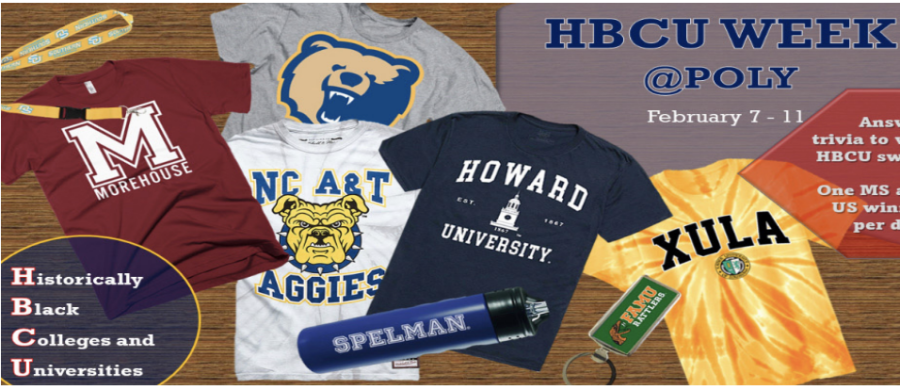Poly Introduces its First HBCU Week
Editor’s Note: This article has been updated to include quotes from Poly librarian Iman Powe-Maynard and further details about the events of HBCU week.
The month of February is known as Black History Month and for the first time, Poly held its own week dedicated to Historically Black Colleges and Universities (HBCU). HBCU week is nationally designated as the second week of September but Poly hosted HBCU week in the second week of February. (Iman Powe-Maynard, a Poly librarian, clarified that Poly’s HBCU week was unrelated to the national HBCU week.) The week was completed with a series of events aimed at raising awareness about HBCU.
Powe-Maynard thought of the idea for HBCU week at Poly after speaking to Omari Keeles, Director of Diversity, Equity and Inclusion, and learning that numerous Poly faculty are HBCU graduates, including both of them. Powe-Maynard’s objective was to increase students of color’s “sense of belonging” at Poly. To encourage engagement in this goal, Poly hosted events the week of February 7. Throughout the week, there was a slideshow in the library displaying the notable alumni that have attended some of these colleges, including Kamala Harris, a Howard University graduate and Morehouse alum Rev. Dr. Martin Luther King Jr. There was also an HBCU trivia question every day. The first Upper School and Middle School student to get the trivia right won swag from the HBCU of their choice, as well as earned Spirit Cup points for their respective groups.
On Monday, February 7, there was a panel discussion in front of the high school student body about why students should attend HBCUs and to address what an HBCU is.
On Wednesday, Gabby Perry ’22 and Chaliya Holder ’22 ran a panel discussion about language use and cultural appropriation, among other things, composed of Black Upper School students. A student on this panel, Justin Mondesir ’23, said in a later interview, “[the goal is to] creat[e] a week to open up the conversation for young students of color to get an opportunity to be in an environment where they’re no longer a minority.”
On Thursday, there was a micro fair in the Library that screened the HBCU documentary, Tell Them We Are Rising: The Story of Black Colleges and Universities. To conclude the week, there was a HBCU vs PWI (Predominantly White Institution) discussion in the Theater during clubs block.
Olivia Umeh ’23, who attended this discussion, said, “The HBCU panel this afternoon really cleared up some of the main questions I had about applying to a historically Black university. Being able to hear perspectives of alumni who had similar high school experiences to mine [as a Black student at a PWI] assured me that any skepticism I have about applying to an HBCU is natural, but also that attending one would be a welcoming, once-in-a-lifetime experience.”
From the start of this week, Powe-Maynard noted that excitement was high in the Poly community. She noted that alumni were enthused about this week and during the panel discussion, two alumni and a special guest, Spelman College graduate Adia Benjamin ‘20, Howard University Law Student Drew Lewis, and Morehouse student Elijah Megginson, spoke about their experiences at HBCUs, two on zoom and one in person. The Poly Prep step team, Epiphany, also delivered a powerful performance during an assembly. Before they performed, Dr. Angela Gittens, the faculty advisor for Epiphany, gave a history of stepping and its significance in connection to HBCUs. Stepping began in the late 1800s in the form of African gumboot dance, Gittens explained. In South African gold mines, Black workers were controlled by the white minority. They were given clunky gumboots so their feet would stay dry and the use of traditional language was forbidden, as they tried to force these workers to assimilate to Western culture. They would stomp and slap their gumboots to make noise in order to communicate. Gumboot dancing is one of the things that influenced modern stepping. Step came out of Greek life at HBCUs and eventually spread nationwide. It has historically been used to further freedom of expression and as a tool for protest.
Powe-Maynard also mentioned being aware “challenges regarding DEIB issues.” This idea was an extension of how to combat these issues. On the Poly HBCU week website, it says, “Poly is healing through actively shifting its culture by celebrating and fostering diversity, equity and inclusion while encouraging upstander intervention within our school.”
































